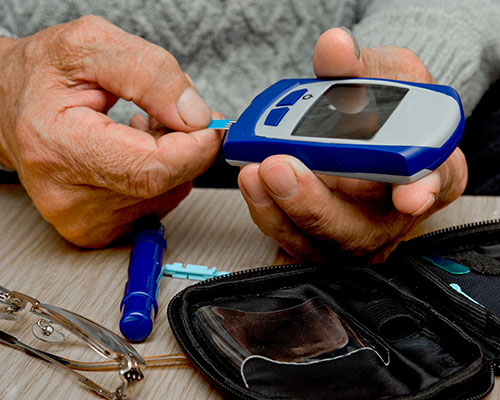
Did you know that about 26% of people with gout also suffer with type 2 diabetes?1 According to the Gout Education Society, having an abnormally high uric acid level may be part of the reason why some people with gout develop this chronic condition.1 Is there a connection between gout and diabetes type 2? If so, how should a person with gout manage this risk?
Understanding gout
Gout can develop when a person has too much uric acid in their body, a medical condition known as hyperuricemia.2 This excess uric acid builds up in the bloodstream because the body either produces too much or releases too little of it.3 After months (even years) of having too much uric acid circulating in the bloodstream, tiny, needle-shaped urate crystals can begin to form around a joint.3 Eventually, these needle-shaped crystals can trigger the sudden and intensely painful episodes known as gout attacks or gout flares.3
Understanding type 2 diabetes
Insulin is a hormone that enables the body to properly use glucose (ie, sugar).4 A person can develop type 2 diabetes when their pancreas either does not produce enough insulin or their body’s cells become resistant to it (a phenomenon known as insulin resistance).4,5 When there is not enough insulin or the body’s cells become insulin resistant, excess sugar can build up in the bloodstream.4 Over time, having excess sugar in the bloodstream can lead to major health problems.4
The potential connection between gout and diabetes type 2
Research indicates that there may be a connection between gout and type 2 diabetes.5,6 Data from a 2010 study published in the American Journal of Medicine showed a possible relationship between higher levels of uric acid and an increased risk of developing type 2 diabetes.5 For every mg/dL increase in the study participants’ uric acid levels, their risk of type 2 diabetes increased by 15-20%.5 The outcome of another study published in 2016 in the Annals of the Rheumatic Diseases provides additional evidence of the connection between gout and diabetes type 2.6 After gathering data on more than 170,000 participants (25,646 men and 9,693 women with gout; 99,175 men and 37,881 women without gout), the researchers found that women who had gout were 71% more likely to develop type 2 diabetes than women who did not have gout.6,7
Risk factors for type 2 diabetes
Risk factors for type 2 diabetes include4:
- Family history. People who have parent(s) or sibling(s) who suffer with type 2 diabetes are more likely to develop the condition.
- Age. The risk of type 2 diabetes increases with age. This may be because people tend to exercise less, lose muscle mass and gain weight as they grow older.
- Race or ethnicity. Black, Hispanic, Native American and Asian American people face a higher risk of developing type 2 diabetes.
- Weight. People who carry extra weight are more likely to develop insulin resistance, which can lead to type 2 diabetes.
- Inactivity. People who are less active have a higher risk of type 2 diabetes.
- Abnormal cholesterol and triglycerides. People with lower-than-normal levels of high-density lipoprotein (HDL, or “good” cholesterol) and high triglyceride levels are more likely to develop type 2 diabetes than people who have cholesterol and triglyceride levels within the normal range.
- Gestational diabetes. Women who developed gestational diabetes while pregnant or gave birth to a baby weighing more than 9 pounds (4 kilograms) have a higher risk of type 2 diabetes.
- Polycystic ovary syndrome (PCOS). Women with PCOS (a common condition characterized by irregular menstrual periods, excess hair growth and obesity) face a higher risk of developing type 2 diabetes.
Recognizing type 2 diabetes symptoms
Common symptoms of type 2 diabetes include4:
- Frequent urination
- Intense thirst
- Intense hunger
- Extreme fatigue
- Blurred vision
- Cuts and bruises that take longer to heal
- Tingling or numbness in the hands and feet
If you experience any of the symptoms above, contact your doctor.4
Managing your gout may help protect your long-term health
According to the Gout Education Society, controlling blood sugar and uric acid levels can help make both diabetes and gout easier to manage.1 Maintaining a healthy uric acid level (6.0 mg/dL or below) is key.1 If you haven’t had your uric acid level checked lately, contact your doctor’s office to request a blood test. (Consider asking your doctor to test the glucose level in your blood as well.) If your uric acid level is higher than 6.0 mg/dL, your doctor may prescribe a urate-lowering therapy such as allopurinol.1,8 Your doctor may also prescribe a colchicine medication such as Mitigare® (Colchicine) 0.6mg Capsules to prevent gout flares.8,9 In addition to medication, consider these lifestyle tips to help you live better with gout and reduce your risk of diabetes:
- Maintain a healthy weight.1 Talk with your doctor about what is considered an appropriate weight for you.
- Exercise regularly.1 Physical activity uses excess glucose as energy, makes your cells more sensitive to insulin and may help you manage your weight.4
- Eat a healthy diet.10 Try lean meat and poultry, lentils and other vegetarian sources of protein, low-fat dairy products and a variety of fruits and vegetables.10
- Drink plenty of water and other unsweetened, nonalcoholic beverages to help flush excess uric acid out of your body.1,8
Mitigare® is a registered trademark of Hikma Pharmaceuticals USA Inc.
Colchicine 0.6 mg capsules are contraindicated in patients with renal or hepatic impairment who are currently prescribed drugs that inhibit both P-gp and CYP3A4. Combining these dual inhibitors with colchicine in patients with renal or hepatic impairment has resulted in life-threatening or fatal colchicine toxicity. Patients with both renal and hepatic impairment should not be given Mitigare®.
Fatal overdoses have been reported with colchicine in adults and children. Keep Mitigare® out of the reach of children.
Blood dyscrasias such as myelosuppression, leukopenia, granulocytopenia, thrombocytopenia and aplastic anemia have been reported with colchicine used in therapeutic doses.
Monitor for toxicity and, if present, consider temporary interruption or discontinuation of colchicine.
Drug interaction with dual P-gp and CYP3A4 inhibitors: Co-administration of colchicine with dual P-gp and CYP3A4 inhibitors has resulted in life-threatening interactions and death.
Neuromuscular toxicity and rhabdomyolysis may occur with chronic treatment with colchicine in therapeutic doses, especially in combination with other drugs known to cause this effect. Patients with impaired renal function and elderly patients (including those with normal renal and hepatic function) are at increased risk. Consider temporary interruption or discontinuation of Mitigare®.
The most commonly reported adverse reactions with colchicine are gastrointestinal symptoms, including diarrhea, nausea, vomiting and abdominal pain.
Please see the full Prescribing Information and Medication Guide for Mitigare® for complete product details.
NOTE: This article was not written by a medical professional and is not intended to substitute for the guidance of a physician. These are not Hikma’s recommendations for gout flare prevention, but rather facts and data collected from various reliable medical sources. For a full list of resources and their attributing links, see below.
